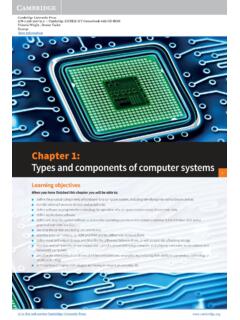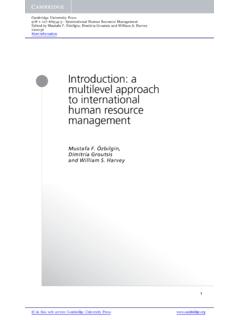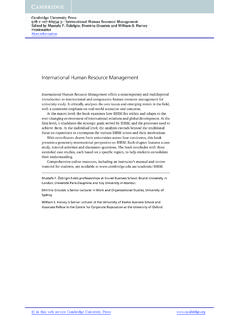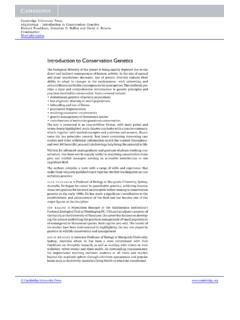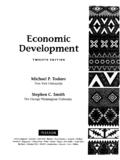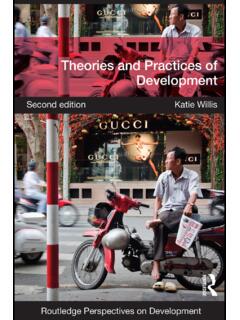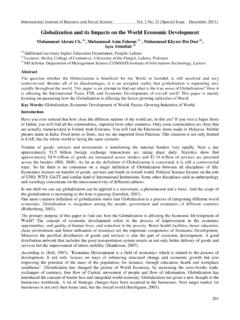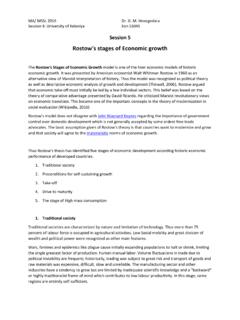Transcription of Socio-Economic Development
1 Socio-Economic DevelopmentWhy are poor countries poor and rich countries rich? How are wealth and poverty related tochanges in health, life expectancy, education, population growth and politics? This non-technical introduction to Development studies explores the dynamics of socio -economicdevelopment and stagnation in developing countries. Thoroughly updated and revised, thissecond edition includes new material on the effects of the 2008financial crisis, theemergence of the BRICS economies, the role of institutions in Development and theaccelerated growth of economies in Africa and Asia.
2 Taking a comparative approach,Szirmai places contemporary debates within their broader contexts and combines insightsand theories from economics, economic history, political science, anthropology and soci-ology. Each chapter includes comparative statistics and time series for thirty-one developingcountries. Assuming no prior knowledge of economics, this book is well suited for studentsin interdisciplinary Development studies and Development economics, for policy makers andfor practitioners pursuing careers in developing Szirmaiis Professorial Fellow at the United Nations University Maastricht Economicand Social Research Institute on Innovation and Technology (UNU-MERIT) and Professorof Development Economics at Maastricht University.
3 His research focuses on the determin-ants of long-run growth, catch-up and stagnation in the developing world, with particularemphasis on the role of the manufacturing sector. A second focus of his research concernsthe relationships between innovation, technological change and economic University Press978-1-107-04595-8 - Socio-Economic Development : Second EditionAdam SzirmaiFrontmatterMore in this web service Cambridge University PressCambridge University Press978-1-107-04595-8 - Socio-Economic Development : Second EditionAdam SzirmaiFrontmatterMore in this web service Cambridge University PressSocio-EconomicDevelopmentSecond editionADAM SZIRMAIM aastricht University/UNU-MERITC ambridge University Press978-1-107-04595-8 - Socio-Economic Development .
4 Second EditionAdam SzirmaiFrontmatterMore in this web service Cambridge University PressUniversity Printing House, Cambridge CB2 8BS, United KingdomCambridge University Press is part of the University of furthers the University s mission by disseminating knowledge in the pursuit ofeducation, learning and research at the highest international levels of on this title: Adam Szirmai 2015 This publication is in copyright. Subject to statutory exceptionand to the provisions of relevant collective licensing agreements,no reproduction of any part may take place without the writtenpermission of Cambridge University published 2005 Second edition 2015 Printed in the United Kingdom by TJ International Ltd.
5 Padstow CornwallA catalogue record for this publication is available from the British LibraryISBN 978-1-107-04595-8 HardbackISBN 978-1-107-62449-8 PaperbackAdditional resources for this publication at University Press has no responsibility for the persistence or accuracy ofURLs for external or third-party internet websites referred to in this publication,and does not guarantee that any content on such websites is, or will remain,accurate or University Press978-1-107-04595-8 - Socio-Economic Development : Second EditionAdam SzirmaiFrontmatterMore in this web service Cambridge University PressCONTENTSList of tablesxvList offiguresxviiList of boxesxviiiPrefacexxiAcknowledgementsxxvL ist of acronyms and abbreviationsxxvi1 Developing countries and the concept of Approaches to The Development Growth and Are growth and Development desirable?
6 Development and Indicators of growth and Does the Third World exist? The gap between rich and poor What do developing countries have in common? The framework of proximate, intermediate and ultimate sources of growthand development37 Questions for review39 Further reading392 Development of the international economic order, 1450 International economic economic breakthrough and external expansion from Western economic growth before Pre-modern international China in the fourteenth andfifteenth Why expansion from Europe instead of from China?
7 European expansion in the Types of international economic Thefirst wave of expansion, 1400 Thefirst wave of The second phase of European expansion, 1815 The period 1870 Non-colonised Latecomers in the process of economic development65 Cambridge University Press978-1-107-04595-8 - Socio-Economic Development : Second EditionAdam SzirmaiFrontmatterMore in this web service Cambridge University The period 1913 The period after the Second World Two perspectives on developments in the world economy, 1450 2015 Key issues in development69 Questions for review70 Further reading713 Growth and stagnation: theories and What are the sources of growth and Development ?
8 Classical thinking about growth, Development and Adam The classical economists Ricardo, Malthus and Friedrich Classical sociologists: Spencer, T nnies and Karl Theories of Max Weber and Joseph Internal and external Explanations of economic rostow s theory of the stages of economic Kuznets preconditions for Neoclassical theories of Growth New growth North and Thomas: efficient Myrdal: institutional Rodrik: identifying the binding constraints to Explanations of Neo-Marxist theories of Structuralism and theories of unequal Underdevelopment theories: an Combining internal and external Advantages of technological Evolutionary theories of economic Empirical study of Development Growth of income per capita: can developing countries escapestagnation?
9 Investment: how important is capital? Export Can primary exporters become manufacturing exporters? Externalfinance: does moneyflow from poor to rich countries? Are developing countries dominated by foreign interests? Are developing countries capable of structural change? How unequal is the income distribution?125 Questions for review128 Further reading129viContentsCambridge University Press978-1-107-04595-8 - Socio-Economic Development : Second EditionAdam SzirmaiFrontmatterMore in this web service Cambridge University Press4 Technology and The role of The technology Technological change and increases in productive How to increase labour productivity?
10 Investing in technological Diffusion of technology and absorptive The knowledge economy: technology, productivity and competitiveness Indicators for science, technology and economic theories about the role of technological change Consequences of the acceleration of technological Development fordeveloping Acceleration of global technological Knowledge New opportunities offered by technological New International technology transfer and technology International technology Intellectual property Absorptive Biotechnology and information and communication Information and communication National and international policy156




